Yinxiao Li
HoliGS: Holistic Gaussian Splatting for Embodied View Synthesis
Jun 24, 2025Abstract:We propose HoliGS, a novel deformable Gaussian splatting framework that addresses embodied view synthesis from long monocular RGB videos. Unlike prior 4D Gaussian splatting and dynamic NeRF pipelines, which struggle with training overhead in minute-long captures, our method leverages invertible Gaussian Splatting deformation networks to reconstruct large-scale, dynamic environments accurately. Specifically, we decompose each scene into a static background plus time-varying objects, each represented by learned Gaussian primitives undergoing global rigid transformations, skeleton-driven articulation, and subtle non-rigid deformations via an invertible neural flow. This hierarchical warping strategy enables robust free-viewpoint novel-view rendering from various embodied camera trajectories by attaching Gaussians to a complete canonical foreground shape (\eg, egocentric or third-person follow), which may involve substantial viewpoint changes and interactions between multiple actors. Our experiments demonstrate that \ourmethod~ achieves superior reconstruction quality on challenging datasets while significantly reducing both training and rendering time compared to state-of-the-art monocular deformable NeRFs. These results highlight a practical and scalable solution for EVS in real-world scenarios. The source code will be released.
Calibrated Multi-Preference Optimization for Aligning Diffusion Models
Feb 04, 2025Abstract:Aligning text-to-image (T2I) diffusion models with preference optimization is valuable for human-annotated datasets, but the heavy cost of manual data collection limits scalability. Using reward models offers an alternative, however, current preference optimization methods fall short in exploiting the rich information, as they only consider pairwise preference distribution. Furthermore, they lack generalization to multi-preference scenarios and struggle to handle inconsistencies between rewards. To address this, we present Calibrated Preference Optimization (CaPO), a novel method to align T2I diffusion models by incorporating the general preference from multiple reward models without human annotated data. The core of our approach involves a reward calibration method to approximate the general preference by computing the expected win-rate against the samples generated by the pretrained models. Additionally, we propose a frontier-based pair selection method that effectively manages the multi-preference distribution by selecting pairs from Pareto frontiers. Finally, we use regression loss to fine-tune diffusion models to match the difference between calibrated rewards of a selected pair. Experimental results show that CaPO consistently outperforms prior methods, such as Direct Preference Optimization (DPO), in both single and multi-reward settings validated by evaluation on T2I benchmarks, including GenEval and T2I-Compbench.
Focus-N-Fix: Region-Aware Fine-Tuning for Text-to-Image Generation
Jan 11, 2025Abstract:Text-to-image (T2I) generation has made significant advances in recent years, but challenges still remain in the generation of perceptual artifacts, misalignment with complex prompts, and safety. The prevailing approach to address these issues involves collecting human feedback on generated images, training reward models to estimate human feedback, and then fine-tuning T2I models based on the reward models to align them with human preferences. However, while existing reward fine-tuning methods can produce images with higher rewards, they may change model behavior in unexpected ways. For example, fine-tuning for one quality aspect (e.g., safety) may degrade other aspects (e.g., prompt alignment), or may lead to reward hacking (e.g., finding a way to increase rewards without having the intended effect). In this paper, we propose Focus-N-Fix, a region-aware fine-tuning method that trains models to correct only previously problematic image regions. The resulting fine-tuned model generates images with the same high-level structure as the original model but shows significant improvements in regions where the original model was deficient in safety (over-sexualization and violence), plausibility, or other criteria. Our experiments demonstrate that Focus-N-Fix improves these localized quality aspects with little or no degradation to others and typically imperceptible changes in the rest of the image. Disclaimer: This paper contains images that may be overly sexual, violent, offensive, or harmful.
DynamicScaler: Seamless and Scalable Video Generation for Panoramic Scenes
Dec 15, 2024Abstract:The increasing demand for immersive AR/VR applications and spatial intelligence has heightened the need to generate high-quality scene-level and 360{\deg} panoramic video. However, most video diffusion models are constrained by limited resolution and aspect ratio, which restricts their applicability to scene-level dynamic content synthesis. In this work, we propose the DynamicScaler, addressing these challenges by enabling spatially scalable and panoramic dynamic scene synthesis that preserves coherence across panoramic scenes of arbitrary size. Specifically, we introduce a Offset Shifting Denoiser, facilitating efficient, synchronous, and coherent denoising panoramic dynamic scenes via a diffusion model with fixed resolution through a seamless rotating Window, which ensures seamless boundary transitions and consistency across the entire panoramic space, accommodating varying resolutions and aspect ratios. Additionally, we employ a Global Motion Guidance mechanism to ensure both local detail fidelity and global motion continuity. Extensive experiments demonstrate our method achieves superior content and motion quality in panoramic scene-level video generation, offering a training-free, efficient, and scalable solution for immersive dynamic scene creation with constant VRAM consumption regardless of the output video resolution. Our project page is available at \url{https://dynamic-scaler.pages.dev/}.
A Simple Approach to Unifying Diffusion-based Conditional Generation
Oct 15, 2024
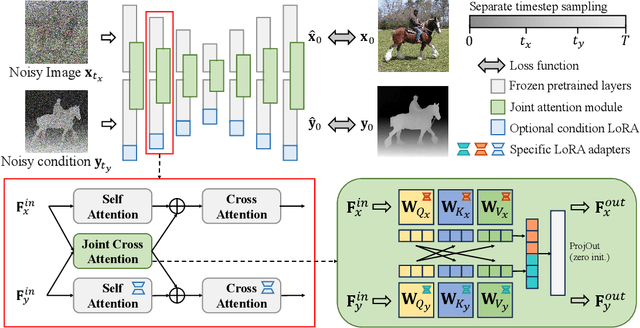
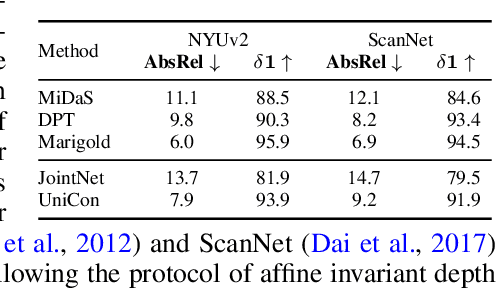
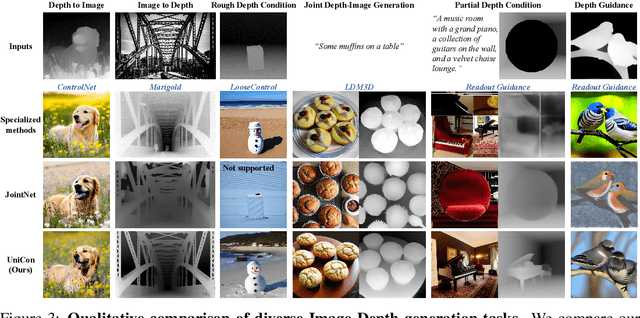
Abstract:Recent progress in image generation has sparked research into controlling these models through condition signals, with various methods addressing specific challenges in conditional generation. Instead of proposing another specialized technique, we introduce a simple, unified framework to handle diverse conditional generation tasks involving a specific image-condition correlation. By learning a joint distribution over a correlated image pair (e.g. image and depth) with a diffusion model, our approach enables versatile capabilities via different inference-time sampling schemes, including controllable image generation (e.g. depth to image), estimation (e.g. image to depth), signal guidance, joint generation (image & depth), and coarse control. Previous attempts at unification often introduce significant complexity through multi-stage training, architectural modification, or increased parameter counts. In contrast, our simple formulation requires a single, computationally efficient training stage, maintains the standard model input, and adds minimal learned parameters (15% of the base model). Moreover, our model supports additional capabilities like non-spatially aligned and coarse conditioning. Extensive results show that our single model can produce comparable results with specialized methods and better results than prior unified methods. We also demonstrate that multiple models can be effectively combined for multi-signal conditional generation.
Cropper: Vision-Language Model for Image Cropping through In-Context Learning
Aug 14, 2024



Abstract:The goal of image cropping is to identify visually appealing crops within an image. Conventional methods rely on specialized architectures trained on specific datasets, which struggle to be adapted to new requirements. Recent breakthroughs in large vision-language models (VLMs) have enabled visual in-context learning without explicit training. However, effective strategies for vision downstream tasks with VLMs remain largely unclear and underexplored. In this paper, we propose an effective approach to leverage VLMs for better image cropping. First, we propose an efficient prompt retrieval mechanism for image cropping to automate the selection of in-context examples. Second, we introduce an iterative refinement strategy to iteratively enhance the predicted crops. The proposed framework, named Cropper, is applicable to a wide range of cropping tasks, including free-form cropping, subject-aware cropping, and aspect ratio-aware cropping. Extensive experiments and a user study demonstrate that Cropper significantly outperforms state-of-the-art methods across several benchmarks.
Parrot: Pareto-optimal Multi-Reward Reinforcement Learning Framework for Text-to-Image Generation
Jan 11, 2024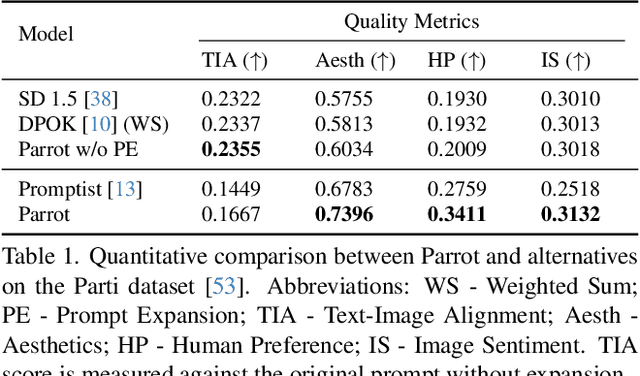

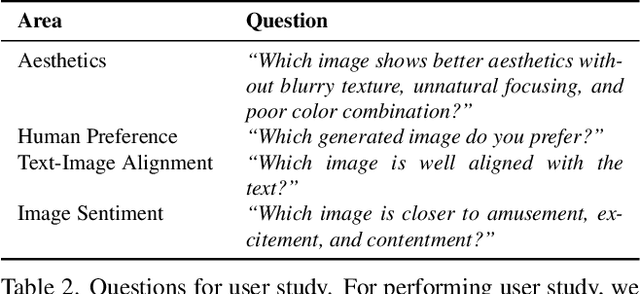
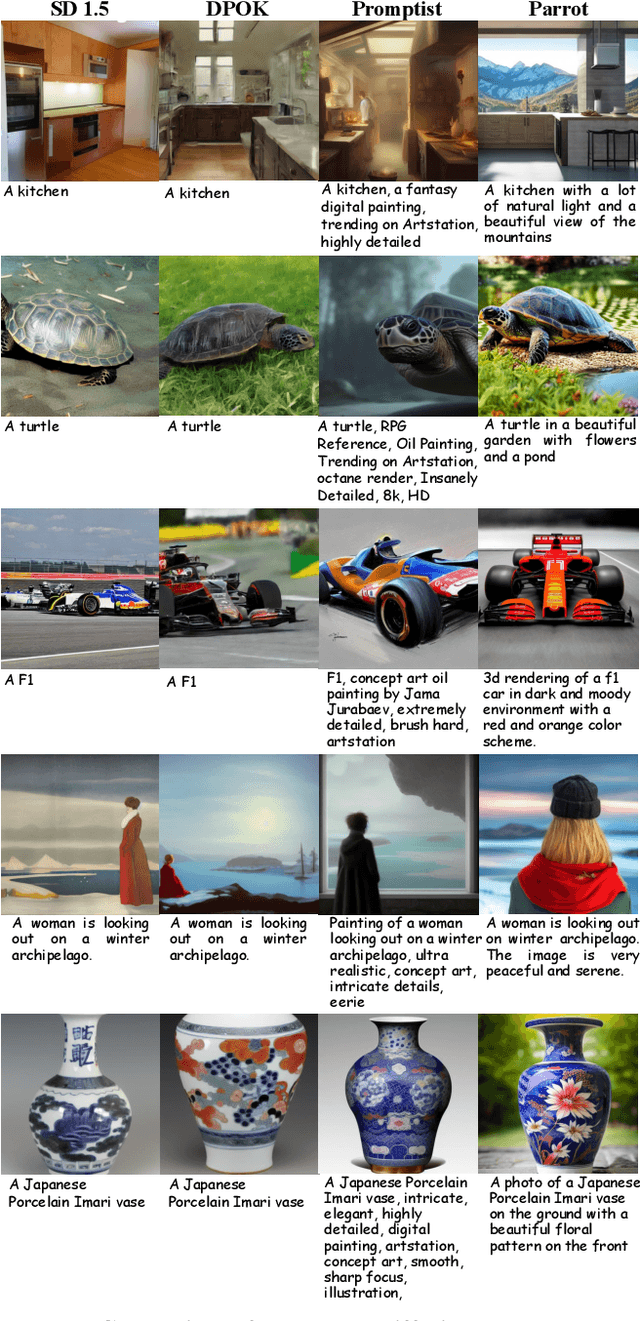
Abstract:Recent works demonstrate that using reinforcement learning (RL) with quality rewards can enhance the quality of generated images in text-to-image (T2I) generation. However, a simple aggregation of multiple rewards may cause over-optimization in certain metrics and degradation in others, and it is challenging to manually find the optimal weights. An effective strategy to jointly optimize multiple rewards in RL for T2I generation is highly desirable. This paper introduces Parrot, a novel multi-reward RL framework for T2I generation. Through the use of the batch-wise Pareto optimal selection, Parrot automatically identifies the optimal trade-off among different rewards during the RL optimization of the T2I generation. Additionally, Parrot employs a joint optimization approach for the T2I model and the prompt expansion network, facilitating the generation of quality-aware text prompts, thus further enhancing the final image quality. To counteract the potential catastrophic forgetting of the original user prompt due to prompt expansion, we introduce original prompt centered guidance at inference time, ensuring that the generated image remains faithful to the user input. Extensive experiments and a user study demonstrate that Parrot outperforms several baseline methods across various quality criteria, including aesthetics, human preference, image sentiment, and text-image alignment.
SVDiff: Compact Parameter Space for Diffusion Fine-Tuning
Mar 22, 2023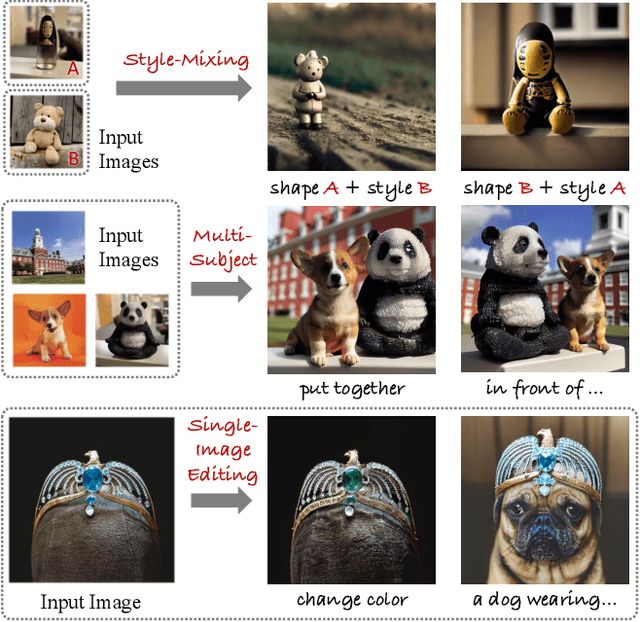

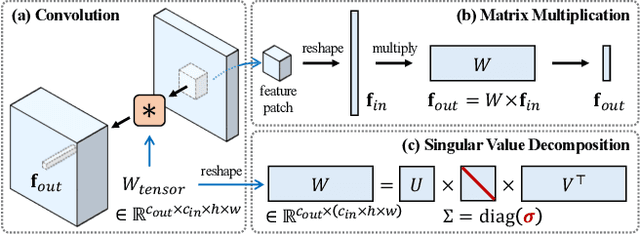

Abstract:Diffusion models have achieved remarkable success in text-to-image generation, enabling the creation of high-quality images from text prompts or other modalities. However, existing methods for customizing these models are limited by handling multiple personalized subjects and the risk of overfitting. Moreover, their large number of parameters is inefficient for model storage. In this paper, we propose a novel approach to address these limitations in existing text-to-image diffusion models for personalization. Our method involves fine-tuning the singular values of the weight matrices, leading to a compact and efficient parameter space that reduces the risk of overfitting and language-drifting. We also propose a Cut-Mix-Unmix data-augmentation technique to enhance the quality of multi-subject image generation and a simple text-based image editing framework. Our proposed SVDiff method has a significantly smaller model size (1.7MB for StableDiffusion) compared to existing methods (vanilla DreamBooth 3.66GB, Custom Diffusion 73MB), making it more practical for real-world applications.
MaxViT: Multi-Axis Vision Transformer
Apr 04, 2022



Abstract:Transformers have recently gained significant attention in the computer vision community. However, the lack of scalability of self-attention mechanisms with respect to image size has limited their wide adoption in state-of-the-art vision backbones. In this paper we introduce an efficient and scalable attention model we call multi-axis attention, which consists of two aspects: blocked local and dilated global attention. These design choices allow global-local spatial interactions on arbitrary input resolutions with only linear complexity. We also present a new architectural element by effectively blending our proposed attention model with convolutions, and accordingly propose a simple hierarchical vision backbone, dubbed MaxViT, by simply repeating the basic building block over multiple stages. Notably, MaxViT is able to "see" globally throughout the entire network, even in earlier, high-resolution stages. We demonstrate the effectiveness of our model on a broad spectrum of vision tasks. On image classification, MaxViT achieves state-of-the-art performance under various settings: without extra data, MaxViT attains 86.5\% ImageNet-1K top-1 accuracy; with ImageNet-21K pre-training, our model achieves 88.7\% top-1 accuracy. For downstream tasks, MaxViT as a backbone delivers favorable performance on object detection as well as visual aesthetic assessment. We also show that our proposed model expresses strong generative modeling capability on ImageNet, demonstrating the superior potential of MaxViT blocks as a universal vision module. We will make the code and models publicly available.
MAXIM: Multi-Axis MLP for Image Processing
Jan 09, 2022
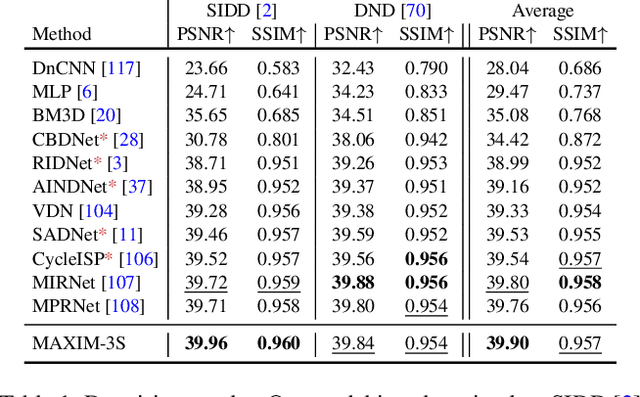


Abstract:Recent progress on Transformers and multi-layer perceptron (MLP) models provide new network architectural designs for computer vision tasks. Although these models proved to be effective in many vision tasks such as image recognition, there remain challenges in adapting them for low-level vision. The inflexibility to support high-resolution images and limitations of local attention are perhaps the main bottlenecks for using Transformers and MLPs in image restoration. In this work we present a multi-axis MLP based architecture, called MAXIM, that can serve as an efficient and flexible general-purpose vision backbone for image processing tasks. MAXIM uses a UNet-shaped hierarchical structure and supports long-range interactions enabled by spatially-gated MLPs. Specifically, MAXIM contains two MLP-based building blocks: a multi-axis gated MLP that allows for efficient and scalable spatial mixing of local and global visual cues, and a cross-gating block, an alternative to cross-attention, which accounts for cross-feature mutual conditioning. Both these modules are exclusively based on MLPs, but also benefit from being both global and `fully-convolutional', two properties that are desirable for image processing. Our extensive experimental results show that the proposed MAXIM model achieves state-of-the-art performance on more than ten benchmarks across a range of image processing tasks, including denoising, deblurring, deraining, dehazing, and enhancement while requiring fewer or comparable numbers of parameters and FLOPs than competitive models.
 Add to Chrome
Add to Chrome Add to Firefox
Add to Firefox Add to Edge
Add to Edge